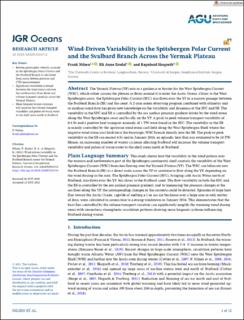| dc.contributor.author | Nilsen, Frank | |
| dc.contributor.author | Ersdal, Eli Anne | |
| dc.contributor.author | Skogseth, Ragnheid | |
| dc.date.accessioned | 2022-05-03T13:31:01Z | |
| dc.date.available | 2022-05-03T13:31:01Z | |
| dc.date.created | 2021-10-08T08:32:43Z | |
| dc.date.issued | 2021 | |
| dc.identifier.issn | 2169-9275 | |
| dc.identifier.uri | https://hdl.handle.net/11250/2993980 | |
| dc.description.abstract | The Yermak Plateau (YP) acts as a guidance or barrier for the West Spitsbergen Current (WSC), which either crosses the plateau or flows around it to enter the Arctic Ocean. Closer to the West Spitsbergen coast, the Spitsbergen Polar Current (SPC) also flows over the YP in a narrow passage between the Svalbard Branch (SB) and the coast. A 2-year ocean observing program combined with altimetry and re-analysis wind data has given new knowledge on the variability and dynamics of the SPC and SB. The variability in the SPC and SB is controlled by the sea surface pressure gradient driven by the wind stress along the West Spitsbergen coast and locally on the YP. A peak-to-peak volume transport variability of 0.8 Sv and a positive heat transport anomaly of 3 TW were found in the SPC. The variability in the SB is mainly controlled by the upstream wind stress curl field along the West Spitsbergen Shelf where the negative wind stress curl field force the barotropic WSC branch directly into the SB. The peak-to-peak variability in the SB can exceed 4 Sv and in January 2016, an episodic heat flux was estimated to be 10 TW. Hence, an increasing number of winter cyclones affecting Svalbard will increase the volume transport variability and pulses of warm water to the shelf areas north of Svalbard. | en_US |
| dc.language.iso | eng | en_US |
| dc.publisher | Wiley | en_US |
| dc.rights | Attribution-NonCommercial-NoDerivatives 4.0 Internasjonal | * |
| dc.rights.uri | http://creativecommons.org/licenses/by-nc-nd/4.0/deed.no | * |
| dc.title | Wind-Driven Variability in the Spitsbergen Polar Current and the Svalbard Branch Across the Yermak Plateau | en_US |
| dc.type | Journal article | en_US |
| dc.type | Peer reviewed | en_US |
| dc.description.version | publishedVersion | en_US |
| dc.rights.holder | Copyright 2021. The Authors | en_US |
| dc.source.articlenumber | e2020JC016734 | en_US |
| cristin.ispublished | true | |
| cristin.fulltext | original | |
| cristin.qualitycode | 2 | |
| dc.identifier.doi | 10.1029/2020JC016734 | |
| dc.identifier.cristin | 1944332 | |
| dc.source.journal | Journal of Geophysical Research (JGR): Oceans | en_US |
| dc.relation.project | Norges forskningsråd: 276730 | en_US |
| dc.identifier.citation | Journal of Geophysical Research: Oceans. 2021, 126 (9), e2020JC016734. | en_US |
| dc.source.volume | 126 | en_US |
| dc.source.issue | 9 | en_US |

